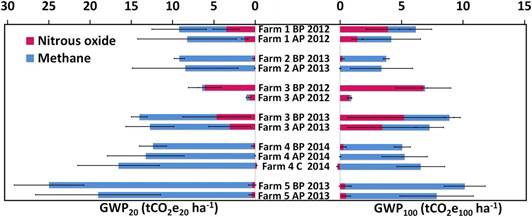水稻种植对全球变暖的影响可能被低估

美国《国家科学院学报》刊载的一项研究显示,如把一氧化二氮排放考虑在内,水稻种植对全球变暖的影响可能比此前估计水平高出近一倍。
美国环境保护基金组织的研究称,近年来,水资源短缺导致越来越多的地区采用间歇性淹水法种植水稻。但在分析稻田对气候的影响时,间歇性淹水稻田释放的高水平一氧化二氮此前并未被计算在内,导致水稻种植对全球变暖的影响被严重低估。
一氧化二氮,又称氧化亚氮,是重要的长效温室气体。在20年到100年时段中,其捕获大气热量的能力是甲烷的数倍。最新研究显示,间歇性淹水稻田释放的一氧化二氮水平高达持续性淹水稻田的30到45倍,后者释放的主要温室气体是甲烷。
研究小组通过稻田实地测量及估算发现,从全球范围内来看,间歇性淹水稻田和持续性淹水稻田释放的甲烷和一氧化二氮等温室气体,对全球变暖的长期影响相当于约600个燃煤电厂的增温效应。
更值得担心的是,目前水稻种植中用于降低甲烷排放的灌溉和有机质管理技术反而会使一氧化二氮排放增加。
该研究称,包括美国、中国、印度在内的多数水稻生产国都没有将与水稻种植有关的一氧化二氮排放计入向联合国提交的国家温室气体排放清单中。
研究人员建议,如果使用浅灌而非间歇性淹水,灌溉式水稻种植对全球气候变化的影响有望降低六成。而如果将浅灌与氮和有机质管理精心结合起来,甚至可使某些农场的温室气体净排放降低九成。(来源:新华网)
High nitrous oxide fluxes from rice indicate the need to manage water for both long- and short-term climate impacts
Abstract Global rice cultivation is estimated to account for 2.5% of current anthropogenic warming because of emissions of methane (CH4), a short-lived greenhouse gas. This estimate assumes a widespread prevalence of continuous flooding of most rice fields and hence does not include emissions of nitrous oxide (N2O), a long-lived greenhouse gas. Based on the belief that minimizing CH4 from rice cultivation is always climate beneficial, current mitigation policies promote increased use of intermittent flooding. However, results from five intermittently flooded rice farms across three agroecological regions in India indicate that N2O emissions per hectare can be three times higher (33 kg-N2O?ha?1?season?1) than the maximum previously reported. Correlations between N2O emissions and management parameters suggest that N2O emissions from rice across the Indian subcontinent might be 30–45 times higher under intensified use of intermittent flooding than under continuous flooding. Our data further indicate that comanagement of water with inorganic nitrogen and/or organic matter inputs can decrease climate impacts caused by greenhouse gas emissions up to 90% and nitrogen management might not be central to N2O reduction. An understanding of climate benefits/drawbacks over time of different flooding regimes because of differences in N2O and CH4 emissions can help select the most climate-friendly water management regimes for a given area. Region-specific studies of rice farming practices that map flooding regimes and measure effects of multiple comanaged variables on N2O and CH4 emissions are necessary to determine and minimize the climate impacts of rice cultivation over both the short term and long term.
原文链接:http://www.pnas.org/content/early/2018/09/04/1809276115

